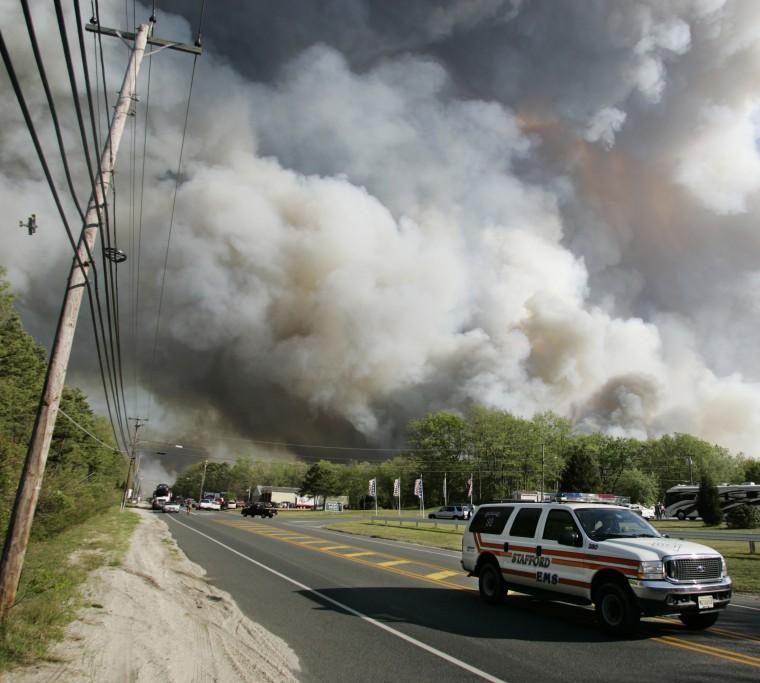Southern wildfires could burn for months before rain snuffs them out
May 16, 2007
Last updated on May 12, 2016 at 11:57 a.m.
FOLKSTON, Ga. – Mark Ruggiero has 400 firefighters, 56 engines, 49 bulldozers and nine helicopters under his command. And that still won’t be enough to snuff out the wildfires that have shrouded the Okefenokee Swamp in smoke and flame for the past month.
His only hope is a big rainstorm just shy of a hurricane. And it could be months before that happens.
“The fire will burn in the swamp until we get a tropical depression that will drop 9 to 10 inches of rain,” said Ruggiero, who has been directing firefighters headquartered at the Okefenokee National Wildlife Refuge. “That’s what it’s going to take.”
The worst wildfires in Georgia since the 1950s have blackened more than 600 square miles of dried-out forest and swampland in drought-stricken southeastern Georgia and northern Florida. Commercial timber losses are estimated to be at least $30 million.
Get The Daily Illini in your inbox!
Hundreds of residents from cities up to 100 miles apart have fled their homes for short periods. In Florida, thick curtains of smoke have briefly closely sections of two busy interstate highways, I-10 and I-75.
Inside the swamp, it is so dry that water levels are as much as 2 feet below normal and flames have ample fuel of gallberry, wax myrtle, palmetto and other shrubs and grasses. Thick layers of peat can smolder and burn like charcoal, even several feet beneath the ground.
In those conditions, wildfires can burn for months.
“We’re hoping, praying and doing rain dances to bring that early precipitation,” said Bill Whitaker, owner of the Inn at Folkston on the Okefenokee’s eastern edge. “There’s not a lot you can do.”
But Rick Connell, a long-term fire analyst with the U.S. Forest Service, said that given the extended forecast, the area probably will not get a drenching until hurricane season peaks, perhaps between August and October or November.
The first giant fire started April 16 when a tree fell onto a power line near Waycross. A second blaze was ignited by lightning in the swamp May 5 and rapidly spread into Florida.
The Okefenokee needs periodic fires to purge vegetation that would otherwise turn the swamp into a forest. The firefighters’ main task is to keep the flames from spreading to homes and commercial timberland.
Bill Kitchens, an operations chief for the Okefenokee firefighters, said it should take at least another week before bulldozer crews finish plowing and fortifying control lines around the swamp’s perimeter of more than 200 miles. Barring extreme wind gusts, that would cut off the flames from fuel outside the Okefenokee.
A total of more than 1,360 firefighters are battling the blazes, with help coming from other states, including fire crews from Texas and fire trucks from California.
Fire officials worry that the outside help could evaporate once the summer wildfire season heats up in the West.
“California’s probably going to explode at some point this summer and states like Nevada and Colorado are in drought conditions,” Ruggiero said. “There is a potential for property and lives to be at risk because there’s not enough fire trucks.”
Alan Dozier, forest protection chief for the Georgia Forestry Commission, said he has had to send six bulldozers and two strike teams from Florida back home because of fires there.
“If we don’t calm down here pretty quick, we’re going to be in a tug-of-war for some of the resources we’re using,” he said.
In 2002, a wildfire in the Okefenokee burned nearly 20 square miles before rain doused it almost a year later. Between July 1954 and July 1955, at least five blazes scorched an estimated 56 square miles of the Okefenokee and surrounding timberland. Summer rains finally ended those destructive fires.
Johnny Hickox, 82, helped fight the mid-1950s fires as a bulldozer operator for the Georgia Forestry Commission. He later served as a swamp guide less than a half-mile from his home outside Waycross.
Hickox said most of the swamp’s northern acreage hadn’t burned since the 1950s, and on recent Okefenokee treks he ran into areas where vegetation had grown so thick he could not get his boat through.
He was among a few residents near the park who were ordered to evacuate for a day last month when the flames spread to within a mile of their homes. Hickox stayed behind, ready to douse his house with water.
“The swamp really needed it, but we didn’t,” Hickox said. “I hope I’ve seen my last one.”






